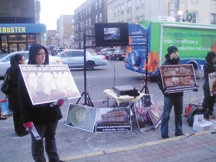Just before Christmas, the animal activist group FAUN staged a demonstration outside of Marzigliano’s Live Poultry Market at 5233 Bergenline Ave. in West New York, complete with a large video screen showing the reality of slaughterhouses and live poultry markets. They also set up a table with pamphlets on meatless alternatives.
The demonstration was no flighty affair, but rather the eighth protest by the group outside the market since October. Another is scheduled for Jan. 15.
For FAUN, which stands for Friends of Animals United NJ, Marzigliano’s gives a face to what they believe is the animal torture that lies behind packaged produce purchased in supermarkets.
But animal rights activists are not the only ones pecking at the market, according to group member Lisa Kahn.
“Not only do we kill them and eat them, but we treat them like crap.” – Lisa Kahn
________
Marzigliano is one of several live markets in the New Jersey/New York area, a staple of Central and South American communities where live markets are a part of the culture.
Though the trend is reflective of homeland preferences, Kahn argues that everybody, regardless of their personal background, has been conditioned to think of animals as food – and that this is not a good thing.
Who they are
Though FAUN was put together only seven months ago by founder Anthony Botti of Long Branch, N.J., the 60-member organization has already done over 50 demonstrations in the metropolitan area, or roughly two per weekend.
According to the FAUN website, the organization “ is firmly united in our commitment to publicizing animal-use industries’ profit-driven lies and illusions.”
They do demonstrations and protests where animals suffer most, whether for animal research at the University of Medicine and Dentistry in Newark or at Winters Furs in Red Bank.
“Anytime you mix animals with money, there’s never going to be a humane factory farm,” Kahn said, “Not only do we kill them and eat them, but we treat them like crap, too.”
Live poultry markets
Retail poultry markets fall under state jurisdiction, but if they sell goats, sheep, or cows, the Food Safety and Inspection Service of the U.S. Department of Agriculture steps in.
In the 1935 Supreme Court case Schechter Poultry Corp. v. United States, Justice Oliver Wendell Holmes noted that New York was the largest live poultry market in the United States, with poultry brought in live, butchered, and then sold to butchers and grocers for sale to the public.
Retail live chicken markets in New York City, however, were not common until the last few years, going from six in 1980 to approximately 90 within 20 years, according to a 2000 NY Times article, “Where chickens don’t perch in the meat cooler.”
Customers, the article said, come primarily from Central and South America and the Middle East. As Hispanics become the largest minority consumer group in the United States, new Latino-themed stores have been cropping up all over the United States.
In live markets, chickens kept in cages are customarily killed directly in front of the customer, with a vein or artery sliced with a knife. Sometimes, they are beheaded. The animal may be hung upside down to bleed, then thrown into a scald-water tank to loosen feathers.
The impact of a video
Of the demonstrations, Kahn recognizes that passers-by initially laugh at the video, but that they’re not laughing after a while.
“You’re always going to get people with a defensive attitude about it, and that’s fine. But the reaction of taking a flyer, reading it, talking to us, just having a conversation…So many people have never talked about their food before,” she said.
FAUN is well-equipped to handle the largely Hispanic population of West New York and Union City, with many Spanish-speaking members able to communicate with residents. In addition, all signs and literature are printed in English and Spanish.
Kahn understands the impact of a video, saying that she became a vegan after seeing one, and wanted to give back.
“It’s not just about the poultry market. It’s about animals for food in general.” she said.
